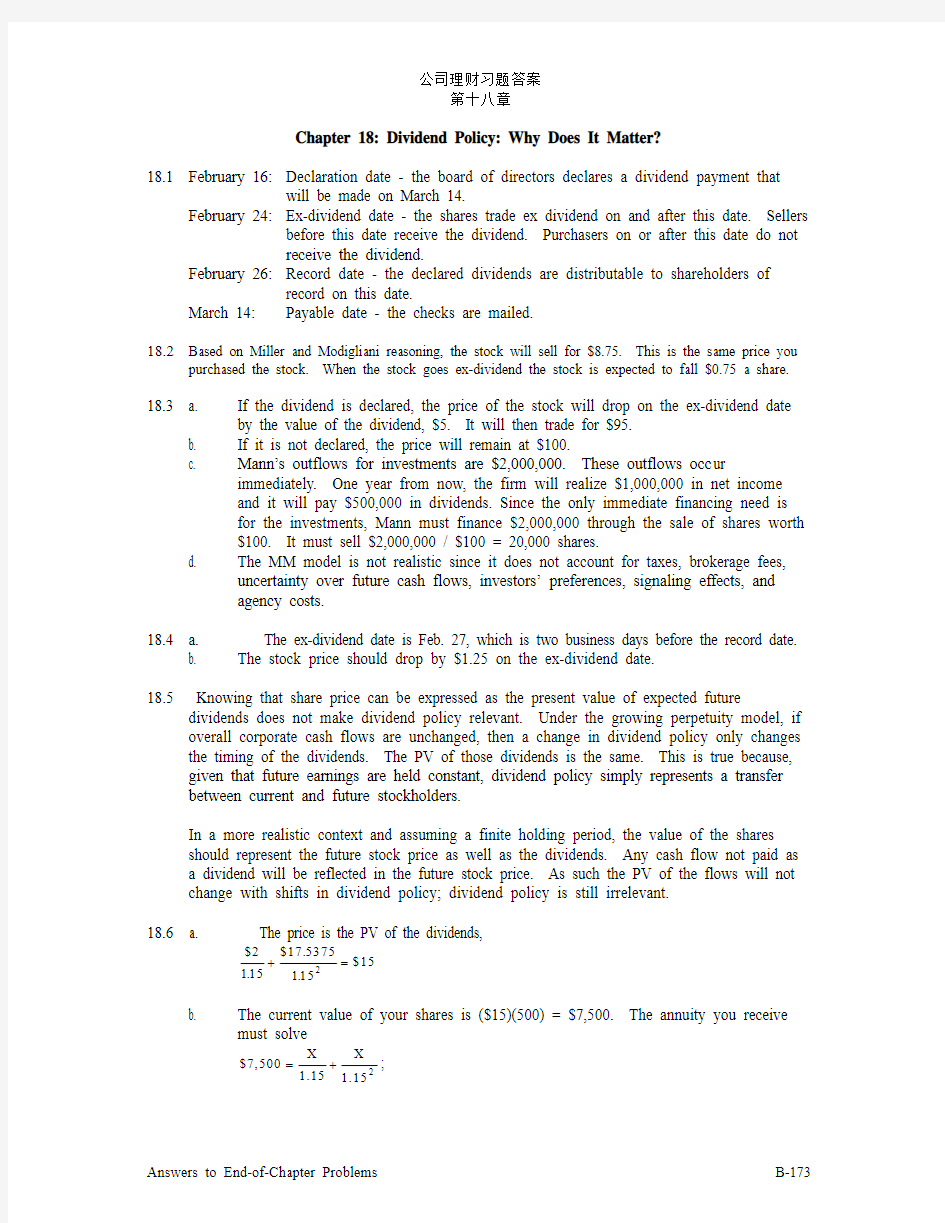罗斯《公司理财》英文习题答案DOCchap018

- 1、下载文档前请自行甄别文档内容的完整性,平台不提供额外的编辑、内容补充、找答案等附加服务。
- 2、"仅部分预览"的文档,不可在线预览部分如存在完整性等问题,可反馈申请退款(可完整预览的文档不适用该条件!)。
- 3、如文档侵犯您的权益,请联系客服反馈,我们会尽快为您处理(人工客服工作时间:9:00-18:30)。
公司理财习题答案
第十八章
Chapter 18: Dividend Policy: Why Does It Matter?
18.1 February 16: Declaration date - the board of directors declares a dividend payment that
will be made on March 14.
February 24: Ex-dividend date - the shares trade ex dividend on and after this date. Sellers before this date receive the dividend. Purchasers on or after this date do not
receive the dividend.
February 26: Record date - the declared dividends are distributable to shareholders of
record on this date.
March 14: Payable date - the checks are mailed.
18.2Based on Miller and Modigliani reasoning, the stock will sell for $8.75. This is the same price you
purchased the stock. When the stock goes ex-dividend the stock is expected to fall $0.75 a share. 18.3 a. If the dividend is declared, the price of the stock will drop on the ex-dividend date
by the value of the dividend, $5. It will then trade for $95.
b. If it is not declared, the price will remain at $100.
c. Mann’s outflows for investments are $2,000,000. These outflows occ ur
immediately. One year from now, the firm will realize $1,000,000 in net income
and it will pay $500,000 in dividends. Since the only immediate financing need is
for the investments, Mann must finance $2,000,000 through the sale of shares worth
$100. It must sell $2,000,000 / $100 = 20,000 shares.
d. The MM model is not realistic since it does not account for taxes, brokerage fees,
uncertainty over future cash flows, investors’ preferences, signaling effects, and
agency costs.
18.4 a. The ex-dividend date is Feb. 27, which is two business days before the record date.
b. The stock price should drop by $1.25 on the ex-dividend date.
18.5 Knowing that share price can be expressed as the present value of expected future
dividends does not make dividend policy relevant. Under the growing perpetuity model, if overall corporate cash flows are unchanged, then a change in dividend policy only changes the timing of the dividends. The PV of those dividends is the same. This is true because, given that future earnings are held constant, dividend policy simply represents a transfer between current and future stockholders.
In a more realistic context and assuming a finite holding period, the value of the shares
should represent the future stock price as well as the dividends. Any cash flow not paid as
a dividend will be reflected in the future stock price. As such the PV of the flows will not
change with shifts in dividend policy; dividend policy is still irrelevant.
18.6 a. The price is the PV of the dividends,
$2 .$17.
.
$15
115
5375
1152
+=
b. The current value of your shares is ($15)(500) = $7,500. The annuity you receive
must solve
$7,500
X
1.15
X
1.152 =+;
